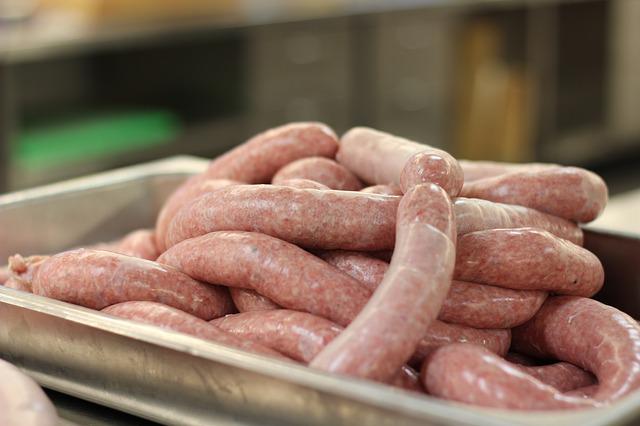Eating raw meat and fish is sometimes customary in certain cultures when prepared the correct way. However, what happens if you eat raw sausage, and how big are the associated risks of it?
About 22% of foodborne illness cases come from ill-prepared meats (such as sausages). If you eat raw sausage, you run the risk of getting a foodborne illness or bacterial infection such as E. coli, trichinosis, botulism, or Hepatitis A, among others.
If you want to learn more about the specific risks of eating raw or undercooked sausage, keep reading. In this article, we’re exploring several of the most common foodborne illnesses that can result from eating raw sausage, as well as the symptoms of these illnesses. Stick around to the end of the article to get answers to frequently asked questions about eating raw sausage!
What Happens If You Eat Raw Sausage?

Although eating raw sausage isn’t the most dangerous thing you can do, it does put you at risk for developing foodborne illnesses from bacteria. Keep in mind that the risks far outweigh any possible benefits when eating raw sausages.
Below, we’ll explore some common illnesses you might contract consuming raw sausage, including the following:
- Trichinosis
- E. coli infection
- Salmonella poisoning
- Listeriosis
- Hepatitis A
- Botulism
- Campylobacteriosis
- Yersinosis
1. Trichinosis
If you eat raw sausage, you run the risk of getting trichinosis – a foodborne disease of the parasitic form that is particularly associated with pork. Since most sausage contains pork, eating it raw means that it may still contain living roundworm larvae infestations known as Trichinella.
The problem that causes trichinosis is that, if you consume these larvae, the worms can start spreading around your body and taking up residence in your muscle tissue (like a parasite).
Most commonly, symptoms of Trichinosis (also called Trichinellosis) are gastrointestinal, such as abdominal pains, diarrhea, loose stool, vomiting, and nausea.
If you leave these symptoms untreated or they become severe and prolonged, they could eventually lead to respiratory problems, brain inflammation, chills, fever, and other issues.
2. E. Coli Infection
Almost everyone has heard of the bacterial infection E. coli and its dangers, including the fact that it can be contagious. In serious cases, this food-borne illness can be fatal, but it also has milder symptoms that occur due to eating undercooked or raw meat.
When you eat raw sausage, you could possibly develop an E. coli infection, especially if the sausage contains a blend of pork with ground beef.
Commonly, E. coli infection leads to gastrointestinal symptoms like nausea, vomiting, diarrhea, bloody loose stool, fever, and abdominal pains.
3. Salmonella Poisoning
Salmonella poisoning is another risk factor associated with consuming raw sausages. According to the Center for Disease Control, there are about 420 salmonella poisoning deaths in the United States every year. Salmonella is a type of bacteria that can cause food-borne illness, and it originates from your meat being contaminated with animal feces.
You could start experiencing GI symptoms (diarrhea, vomiting, nausea, cramps) within six hours of eating raw sausage. Or, it might not set in until almost a week has passed. This poisoning can even cause blood, bone, and urine infections of a serious nature.
4. Listeriosis
Another risk of eating raw sausage is that you may get listeriosis – another foodborne illness caused by bacteria. Unlike salmonella, this bacterial illness of the Listeria bacteria often comes from soil and mud that contaminates your raw meat.
What’s more, is that the symptoms vary slightly from other food-borne illnesses. Here a a few:
- Constipation
- Diarrhea/loose stool
- Headache
- Fever
- Abdominal cramps
- Vomiting
- Nausea
You especially don’t want a baby to experience this food-borne illness, as the symptoms can be more severe, even resulting in difficulty breathing, jaundice, and lethargy.
5. Hepatitis (A)
In rarer cases, you may contract Hepatitis A from consuming raw sausage. According to Johns Hopkins Medicine, this often occurs when food is not prepared with clean measures or it gets contaminated with dirty water.
Symptoms of this are similar to other food-borne illness symptoms, and they mainly include gastrointestinal issues like vomiting, nausea, and diarrhea.
What’s worse about this food poisoning is that you can contract it even if you don’t have the vaccine for it. Hepatitis A is a virus that inflames your liver, but you can recover from it and develop long-term immunity.
6. Botulism
Botulism is pretty rare, and it’s more likely to happen when it comes to canned or jarred foods than it is with meats. However, raw sausage may contain bacteria that causes botulism, especially if it has been fermented.
You really want to watch out for this illness, as it can become fatal in extreme cases. It can slur your speech, cause vomiting, lead to diarrhea, affect your vision, and make your muscles weak.
You may not notice that you’ve developed botulism until about a day has passed, since you ingested undercooked sausage. But if you do, you should contact a medical professional to inquire about treatments.
7. Campylobacteriosis
Campylobacteriosis is another bacterial food poisoning you might get if you ingest raw sausages. It may affect your intestinal tract, or it may target your blood. In some cases, it could lead to severe diarrhea, which can dehydrate you and cause more serious issues. It also causes symptoms such as stomach cramps, vomiting, nausea, bloody loose stool, fever, headaches, and muscle pains.
According to the CDC, this particular bacteria (Campylobacter) is responsible for 1.5 million illnesses in the United States on a yearly basis.
8. Yersinosis
Last but not least, we want to highlight the possibility of getting yersinosis if you eat raw sausage. Yersinosis is a food-borne disease that comes from eating raw meat contaminated with bacteria.
Commonly, this occurs when eating pork, which is one of the main ingredients in many raw sausage products.
The good news is that the symptoms are milder than they are with other food-borne illnesses. But children can suffer from more severe symptoms like diarrhea and fever, while adults generally just experience abdominal pain or fever.
Benefits of Eating Raw Sausage

If you absolutely feel like you need to ignore the risks and see what happens if you eat raw sausage, you may be holding out for the possible benefits.
Sadly, it’s almost impossible to avoid ingesting harmful bacteria from raw sausage. But some people believe that raw meat can salvage more nutrients that you don’t get when you cook the meat.
For example, sausages tend to be rich in iron, which is important in promoting hormone production, muscle growth, and other factors related to development. According to the USDA, raw sausages are also rich in Vitamin B12, magnesium, protein, potassium, and other B vitamins.
But the reality is that the risk of food poisoning and illness that you subject yourself to when eating raw meat is much higher than the possibility that it will enrich you with iron. In fact, consuming raw meat or bacteria-infected meat accounts for 22% of all cases of food-borne illnesses and 29% of deaths.
Frequently Asked Questions
Is it okay for sausage to be a little pink?
When it comes to cooking chicken, for example, the color of the meat is often an indicator of how well-done the meat is, in addition to the internal temperature. But with sausages, which often contain ground pork, the color doesn’t always indicate if the meat is done. Base the “done”-ness of your sausages on their internal temperature, which should be 155–165° F.
How do you tell if sausage is undercooked?
You can determine whether or not your sausages are undercooked by checking their internal temperature with a meat thermometer. It should reach about 160 degrees F to be safe to eat (165 degrees F if you want to take the extra precaution).
How long after eating raw pork will you get sick?
If you do consume raw pork sausage and get a foodborne illness from it, you’ll likely notice symptoms after about 24-48 hours. However, it may take up to a week or two to notice gastrointestinal symptoms, swelling, and other effects.
Is it healthy to eat raw sausages?
Typically, it isn’t healthy to eat raw sausages because of the risk of food poisoning. Although some people believe that eating raw meat preserves more of the nutrients than cooking it does, you aren’t going to benefit much more by eating it raw.
What is raw sausage?
Raw sausage is fermented, raw meat that has been ground and cased in animal intestines or artificial casings. Although you can cure via brining, drying, or smoking, you may still need to cook them before consuming.



Leave A Comment